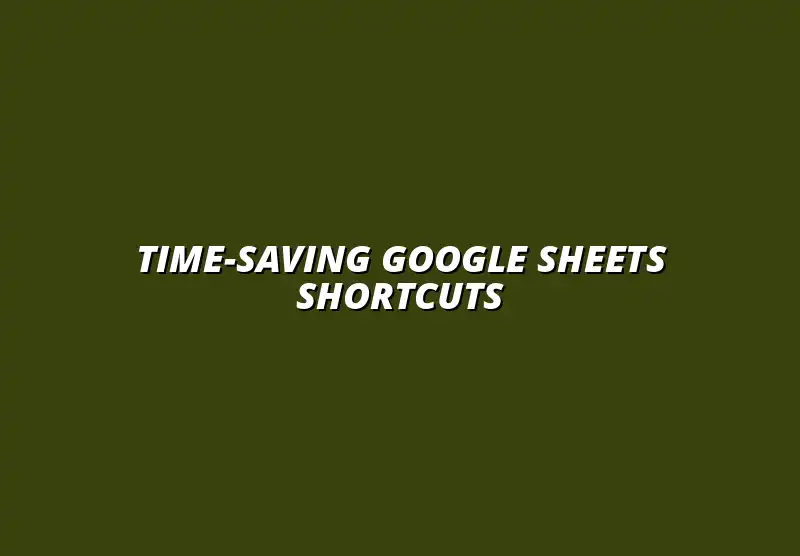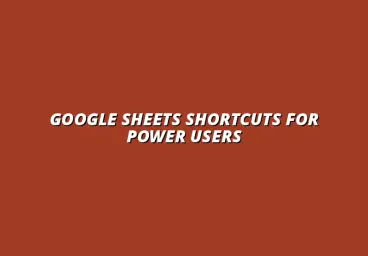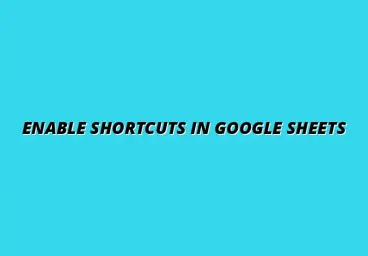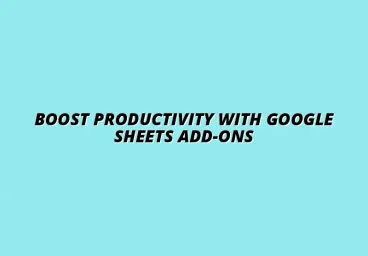Time-Saving Google Sheets Shortcuts

Understanding Time-Saving Shortcuts in Google Sheets
Using Google Sheets can sometimes feel overwhelming, especially when you're juggling a lot of data. That’s where time-saving shortcuts come into play! These shortcuts not only help improve efficiency but also allow you to focus more on analyzing data rather than just entering it.
By learning and utilizing these shortcuts, you can significantly shorten the time spent on repetitive tasks. The more fluent you become in using them, the more streamlined your workflow gets! Efficient spreadsheet management can lead to quicker decision-making and a more productive work environment. For more advanced techniques to boost your productivity, check out this guide on boosting productivity with Google Sheets.
The Importance of Efficiency in Spreadsheet Management
In today’s fast-paced world, efficiency is key. If you’re managing spreadsheets, being able to navigate quickly is crucial. By maximizing efficiency, you can handle larger datasets without feeling stressed and overwhelmed.
Additionally, improving productivity through shortcuts means you can devote more time to analyzing data instead of formatting it. Whether you’re a student or a professional, the ability to work quickly and accurately in Google Sheets is a valuable skill that can set you apart. Learn more about effective data management with Google Sheets to further enhance your skills.
How Time-Saving Shortcuts Enhance Productivity
When you adopt time-saving shortcuts, you’ll find that your productivity levels soar. Here’s how these shortcuts can enhance productivity:
- Reduce the time spent on repetitive tasks.
- Minimize the number of clicks needed to perform actions.
- Allow for quicker access to functions and features.
- Help you to become more comfortable and confident in your spreadsheet skills.
Ultimately, it’s all about working smarter, not harder! With more time freed up, you can focus on critical tasks, leading to better outcomes. Discover essential Google Sheets shortcuts for efficiency to streamline your workflow.
Common Challenges Faced by Google Sheets Users
Despite the advantages, many users encounter challenges when using Google Sheets. For example, a lack of familiarity with shortcuts can make simple tasks take longer than necessary. Here are some common challenges:
- Difficulty in finding specific functions.
- Repetitive data entry tasks that waste time.
- Struggles with navigating large datasets efficiently.
- Lack of knowledge regarding effective formatting options.
Overcoming these challenges begins with understanding the shortcuts available and integrating them into your daily routines. By addressing these obstacles, you can become more proficient and confident in managing your spreadsheets.
Essential Keyboard Shortcuts for Google Sheets
A great way to kickstart your efficiency in Google Sheets is by mastering essential keyboard shortcuts. These shortcuts can enhance your workflow and make navigation a breeze!
From basic movements to more complex formatting, knowing these shortcuts can save you tons of time and ensure that your spreadsheet tasks are handled effortlessly. Let’s dive into the different categories of shortcuts available!
Basic Navigation Shortcuts
One of the first things to learn are navigation shortcuts. These will help you move through cells and sheets with ease. Here’s a list of some essential navigation shortcuts:
- Arrow Keys: Move one cell at a time.
- Ctrl + Arrow Key: Jump to the edge of data regions.
- Page Up/Page Down: Move up or down a screenful of data.
- Ctrl + Home: Go to the beginning of the sheet.
These shortcuts can really speed up your workflow and reduce the frustration of scrolling through large datasets. Once you get the hang of these, you’ll find navigating your sheets becomes second nature! Check out this resource for a comprehensive guide on essential Google Sheets shortcuts.
Efficiently Moving Through Cells and Sheets
Using shortcuts effectively allows you to move through cells and sheets without losing focus. For example, you can quickly jump between sheets by pressing Ctrl + Page Up/Page Down. This is especially useful when you’re working with multiple tabs.
Another handy trick is using Shift + Arrow Key to select multiple cells at once. This helps when you need to copy, format, or delete ranges of data quickly. Mastering these moves adds to your overall efficiency and makes spreadsheet management a lot smoother!
Quickly Accessing Menus and Functions
Accessing menus and functions quickly is also important. With keyboard shortcuts, you can get to your favorite functions without fumbling through menus. Here are a few key shortcuts:
- Alt + Shift + F: Opens the File menu.
- Ctrl + Shift + C: Opens the Format menu for quick formatting options.
- Ctrl + A: Select everything in the sheet.
These shortcuts not only save time but also help you to become more adept at using the various functionalities of Google Sheets. With practice, you’ll find that these shortcuts will become an integral part of your spreadsheet workflow! Learn how to leverage Google Sheets formula shortcuts to further optimize your efficiency.
Formatting and Editing Shortcuts
Formatting and editing are crucial parts of working in Google Sheets, and knowing the right shortcuts can make these tasks much easier! Let’s explore the shortcuts that can streamline these processes.
Using keyboard shortcuts for formatting can save you lots of time when you're trying to make your data look neat and presentable. Whether you need to change font styles or adjust cell colors, these shortcuts will become your best friends!
Streamlining Text Formatting in Google Sheets
Here are some useful shortcuts for text formatting:
- Ctrl + B: Bold text.
- Ctrl + I: Italicize text.
- Ctrl + U: Underline text.
- Ctrl + Shift + L: Add or remove filters.
Implementing these shortcuts can make a big difference in how quickly you can format your sheets. It allows you to focus on your data instead of spending too much time on appearances!
Fast Editing Techniques for Data Management
Editing data efficiently is another skill that can enhance your Google Sheets experience. Here are several editing shortcuts to consider:
- F2: Edit the selected cell.
- Ctrl + Z: Undo the last action.
- Ctrl + Y: Redo the last action.
- Ctrl + Enter: Keep the cell selection after entering data.
Using these shortcuts can help you make quick changes or correct mistakes without losing your flow. These tools empower you to manage your data without unnecessary interruptions!
Formula and Function Shortcuts
Formulas are the backbone of Google Sheets, and knowing how to use shortcuts for them can significantly improve your efficiency. Learning to leverage formula shortcuts allows you to perform complex calculations with ease!
There are various shortcuts that can help you quickly insert functions and manipulate data. This not only saves time but also reduces the chances of errors in your calculations!
Using Keyboard Shortcuts for Common Functions
Here are some handy shortcuts for inserting common functions:
- =: Start a formula.
- Alt + Shift + F: Opens the function help.
- Ctrl + A: Displays arguments for the function.
- Ctrl + Shift + Enter: Create an array formula.
These shortcuts can save you precious seconds when building formulas. Plus, they keep you from having to navigate through multiple menus, giving you time back for analyzing the results!
Quickly Inserting Functions with Shortcuts
Inserting functions quickly can take your spreadsheet skills to the next level! For instance, you can use the Tab key after typing a function name to auto-complete it. This can make it easier to remember your functions and save typing time.
Additionally, using the Ctrl + Shift + L shortcut can help in adding filters, allowing you to manage and analyze your data more effectively. These little tricks can make a big impact! Explore more time-saving tips with this guide on Google Sheets automation tips.
Data Manipulation Shortcuts
Managing your data efficiently is essential in Google Sheets, and shortcuts can make this process much simpler! Let’s look at shortcuts that help in sorting and filtering data.
By mastering these shortcuts, you can manipulate data without the hassle of going through menus, making your experience much more enjoyable!
Efficiently Sorting and Filtering Data
Here are some important shortcuts for sorting and filtering:
- Ctrl + Shift + R: Sort the selected range.
- Alt + D + S: Open the sort dialog.
- Ctrl + Shift + F: Open the filter menu.
These shortcuts can drastically reduce the time it takes to manage large datasets. The ability to quickly sort or filter can help you uncover insights faster!
Utilizing Shortcuts for Data Entry and Modification
Data entry can be tedious, but with the right shortcuts, it becomes much more manageable. For example, using Ctrl + D can fill down data in a column, saving you from repetitive typing.
Moreover, Ctrl + X, Ctrl + C, and Ctrl + V allow you to cut, copy, and paste data seamlessly. These shortcuts enhance your capability to enter and modify data quickly and efficiently!
Shortcut Customization Options
If you want to make Google Sheets even more personalized, customizing shortcuts can be a game-changer! Tailoring shortcuts to fit your needs ensures that you can work in a way that feels most comfortable for you.
Finding the right shortcuts can save time and make your workflow much smoother. Let's explore how you can create and adjust shortcuts to improve your productivity!
How to Create Your Own Shortcuts in Google Sheets
Customizing your shortcuts can help cater to your specific tasks. While Google Sheets doesn’t offer built-in options for creating shortcuts directly, you can use third-party tools or browser extensions to set them up. Here are some steps to consider:
- Identify functions you use often.
- Look for tools that allow shortcut customization.
- Test your new shortcuts to ensure they work as intended.
Once you have these tailored shortcuts, you’ll find your workflow becomes much more efficient and enjoyable!
Adjusting Default Shortcuts for Improved Workflow
In addition to creating your own shortcuts, you can also adjust the default settings in Google Sheets. This can help streamline your tasks and align the shortcuts more closely with your preferences. Here’s how:
- Access the settings menu in Google Sheets.
- Review the available shortcut options.
- Adjust shortcuts based on your common tasks.
Making these adjustments can lead to a more customized experience, allowing you to execute tasks quicker and with less effort!
Advanced Techniques for Time-Saving in Google Sheets
When it comes to getting the most out of Google Sheets, understanding advanced techniques can be a game changer! By using specific tools and strategies, you can save a lot of time and make your spreadsheet tasks much more efficient. From integrating add-ons to creating templates, these techniques will enhance your overall productivity.
Let’s dive into some of these advanced tips that can elevate your Google Sheets experience. With a little practice, you’ll be able to streamline your workflow and tackle your tasks with ease!
Utilizing Google Sheets Add-ons for Enhanced Functionality
Google Sheets add-ons are powerful tools that can significantly improve your spreadsheet workflow. These add-ons extend the capabilities of Google Sheets, allowing you to perform tasks that would otherwise be time-consuming or complex. You can find a variety of add-ons for different functionalities, such as project management, data analysis, and reporting. Learn how to automate Google Sheets form responses for increased efficiency.
Some popular add-ons that complement shortcuts include:
- Supermetrics: Great for pulling data from marketing platforms.
- Advanced Find & Replace: Helps in searching for and replacing text across your sheets easily.
- Form Publisher: Automates the creation of documents from Google Forms responses.
Integrating these add-ons can automate repetitive tasks, making your work faster and more efficient. With the right combination of shortcuts and add-ons, you can take your Google Sheets game to the next level!
Creating Templates to Save Time
Templates can be a huge time-saver, especially for tasks you perform frequently. By designing custom templates for repeated use, you can avoid starting from scratch each time. This is especially useful for reports, budgets, and tracking sheets.
Here are some tips for creating effective templates:
- Identify Repetitive Tasks: Determine what you often do in Google Sheets and design templates around those needs.
- Incorporate Pre-Formatted Elements: Make sure your templates include headings, data validation, and other useful features.
- Utilize Existing Templates: Google Sheets offers a variety of pre-made templates that can be customized to fit your needs.
By leveraging existing templates or designing your own, you can increase efficiency and keep your workflow smooth!
Collaboration Tools and Shortcuts
Collaboration is key in many work environments, and Google Sheets offers fantastic tools to work together seamlessly. Using shortcuts to enhance team collaboration can help keep everything organized and efficient. For example, using the commenting feature allows you to ask questions or give feedback directly within the sheet.
Here are some collaboration shortcuts to enhance your teamwork:
- Ctrl + Alt + M: Add a comment to a cell.
- Ctrl + K: Insert a link in your sheet.
- Ctrl + Shift + V: Paste values only, which can be useful for sharing data without formatting.
Additionally, Google Sheets allows for real-time editing, making it easy to see changes as they happen. You can communicate with team members directly within the spreadsheet, ensuring everyone is on the same page!
Addressing Common Questions About Google Sheets Shortcuts
As you delve deeper into using Google Sheets, you might have some questions about shortcuts and their functionalities. Understanding these aspects can make your experience even smoother and more enjoyable. Let's explore some common questions and their answers!
What Are the Most Frequently Used Shortcuts for Beginners?
If you're new to Google Sheets, it’s helpful to know which shortcuts can make your life easier. Mastering a few essential shortcuts can drastically reduce your learning curve and enhance your efficiency. Here are some of the most frequently used shortcuts for beginners:
- Ctrl + C: Copy the selected cells.
- Ctrl + V: Paste copied cells.
- Ctrl + Z: Undo your last action.
- Ctrl + Y: Redo your last action.
While these are great starting points, it’s also important to recognize the limitations of shortcuts. Some functions may not work seamlessly with certain devices or browsers.
How Can I Troubleshoot Shortcut Issues in Google Sheets?
Sometimes, you might encounter issues with shortcuts not working as expected. Identifying these common problems can save you a lot of frustration. Here are some common troubleshooting steps:
- Check Your Browser: Make sure you are using a compatible browser, as some shortcuts may not function in all browsers.
- Refresh Your Page: A simple refresh can often resolve minor glitches.
- Clear Cache: Clearing your browser’s cache can help with performance issues.
To maintain shortcut functionality, regularly check for updates to your browser and Google Sheets. Staying up-to-date can help you avoid potential issues!
Summing Up Effective Strategies for Time Optimization
In conclusion, mastering advanced techniques for optimizing your time in Google Sheets involves using a combination of shortcuts and tools. Whether it's through add-ons, custom templates, or collaboration features, each element plays a significant role in enhancing your productivity.
By implementing these strategies in your daily tasks, you can encourage a culture of continuous learning and adaptation. With each new skill you acquire, you’ll find your efficiency in Google Sheets improving, making your work not just faster, but also more enjoyable!
Popular Posts
 Understanding the Importance of Shortcuts in Google Sheets for Power Users
When it comes to working
Understanding the Importance of Shortcuts in Google Sheets for Power Users
When it comes to working
 Understanding Google Sheets and Its Importance
Google Sheets is a powerful, web-based spreadsheet ap
Understanding Google Sheets and Its Importance
Google Sheets is a powerful, web-based spreadsheet ap
 Understanding Shortcuts in Google Sheets
When it comes to working efficiently with Google Sheets, kn
Understanding Shortcuts in Google Sheets
When it comes to working efficiently with Google Sheets, kn
 Understanding the Value of Add-ons in Google Sheets for Enhanced Productivity
Google Sheets is a pow
Understanding the Value of Add-ons in Google Sheets for Enhanced Productivity
Google Sheets is a pow
